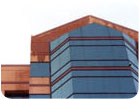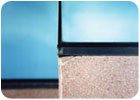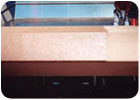
All exterior building materials are susceptible to allowing moisture infiltration into the interior of the structure. Due to this fact, a significant opportunity is presented to exterior restoration contractors to conduct preventative maintenance on exterior building components. The main function of these practices is to keep water out of the building and-more importantly-to prevent moisture intrusion into the exterior building material. Moisture entry into exterior materials will, overtime, contribute to structural damage, which will require total material restoration.
Points of moisture ingress differ based on the employed exterior building system. Construction joints are the most probable areas of moisture intrusion and they should be routinely inspected for openings and/or material separation from the substrate. Preventive measures at construction joints should include proper repair to all openings and irregularities. Repairs are typically completed with construction sealants. Proper repair methods of sealants require the full removal of the existing sealant and thorough joint preparation prior to the application of the new sealant. In most instances, applying sealant over existing sealant only contributes to further material deterioration.
Materials high in porosity, such as brick, concrete, limestone, etc., are also vulnerable to moisture infiltration. The porosity of masonry materials make them permeable to moisture because their interior structures are made up of interconnected pores and capillaries. Moisture in its liquid state flows through these passageways from capillary action (suction). The volume of moisture flow depends on pore sizes and capillary structures.
Moisture entry in masonry exteriors is probable at (hairline) cracks, settlement cracks, joint separations and pores, particularly from weather aging of the substrate. Moisture entry contributes to masonry destruction from cracking, efflorescence and soiling and staining of light-colored surfaces.

Sealers or Penetrants
Preventative measures required over porous materials typically include the application of water repellents. Water repellents are typically manufactured with a monomeric or polymeric resin that is dissolved into an organic solvent or water. They are defined commercially by their most active resin, such as acrylic, silane, state, etc. Exterior water repellents can be classified as sealers (film formers) or penetrants.Sealers fill the masonry pores and form a continuous film over the masonry material. These products often provide a gloss or sheen over the surface and are routinely specified by architects to intensify the color of the substrate. Acrylic resins are commonly used in sealers.
Penetrants line the masonry pores and form a protective barrier against moisture infiltration into the substrate. Silanes and siloxane resins are typically used in penetrants because they contain catalysts that promote the proper reactions with the masonry material.
Limitations of Use
As with all construction materials, the success of the application is heavily dependent on proper use. The materials should be properly researched for limitations of use. There are several situations where repellants should not be used. Repellants should not be used in below grade applications where hydrostatic pressure exists. These types of applications require (by code) waterproofing membranes.Repellants should never be applied as repair treatments of cracks, voids, damaged masonry or any other deformations. Repairs of this nature require the use of proper patching materials. Furthermore, all required repairs should be completed prior to the application of water repellants.
In remedial applications existing repellants must be adequately removed from the surface. Some repellants do not adhere properly to new masonry mortars or extensive tuck-pointing repairs.
A commonly recognized principal is that repellant treatments that yield a substantial reduction in the water vapor transmission rate of the substrate should be avoided. The concern in these uses is that the repellants can trap moisture in the substrate, contributing to deterioration after freeze/thaw or wet/dry cycles. Common deformations associated with these phenomena include spalling, cracking and subfloresence, which is the accumulation of salts beneath the masonry surface.

Proper Application Methods
Proper surface preparation is critical to the success of the repellant application. The substrate must be prepared in accordance with the repellant manufacturers requirements. Typically, this includes the removal of surface contaminants, such as dirt, grease, staining, previous applications and other irregularities. The amount of preparation is dependent on the existing substrate condition. The applicator should also be aware of the fact that heavy soiling or excessive dampness of the substrate can interfere with the penetration of the treatment, resulting in a poor application.For application over new concrete walls, it is essential that the concrete is dry and properly cured for a minimum of 28 days. Application over uncured concrete or damp surfaces leads to formation of a white haze.
Some water repellants, such as silanes and siloxanes, perform better when they are applied over damp surfaces. However, acrylics require a thoroughly dry surface. Consult the repellant manufacturers technical personnel for proper application requirements.
Repellants are temperature sensitive and should be applied in the proper outdoor conditions. Most manufacturers require that the ambient temperature is within a range of 40 degrees F (minimum) to 100 degrees F (maximum) during application and for a 24 to 48 hour period after application. Application should be completed on dry, non-windy days.
The repellant material should be applied in a continuous flow with an even and uniform application rate throughout the surface. The material coverage rate must be in accordance with the manufacturers requirements, and it should be noted that too much or too little coverage could result in a poor application. The coverage rate will vary depending on the type and condition of the substrate, as well as the texture and porosity of the substrate. Follow the manufacturers requirements for the number of applications-some products require only one application, while others require two.
Once the application has been completed and the material properly cures, a water test should be conducted to determine the success of the application.
Nothing beats experience. The applicators experience in applying these types of materials will contribute to the success of the project. Properly skilled crews can complete these applications in a timely and efficient manner rendering profitable projects. Exterior building contractors can provide repellant applications as preventative maintenance to supplement restoration work.
If you read this article, please circle number 323.

Report Abusive Comment